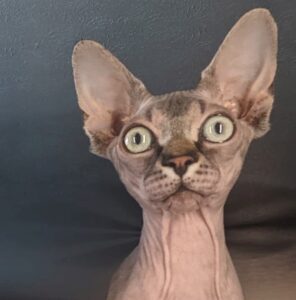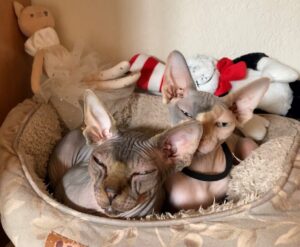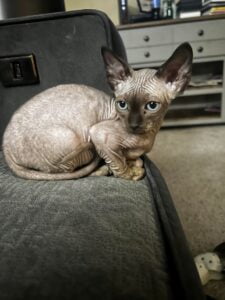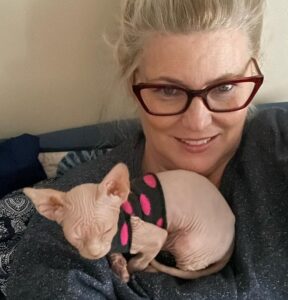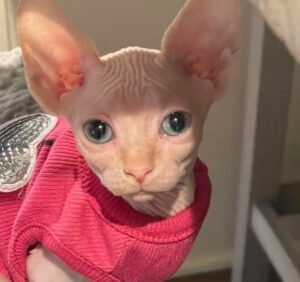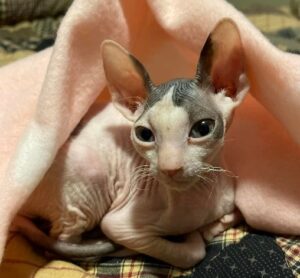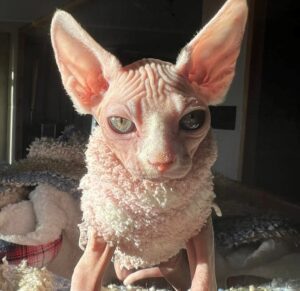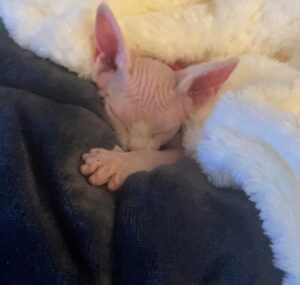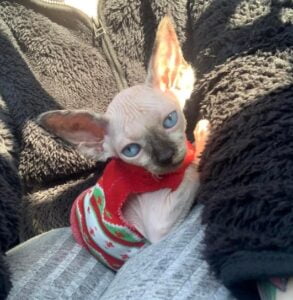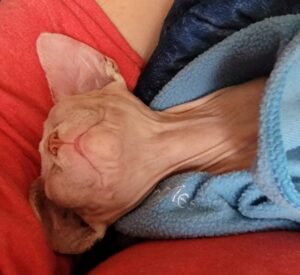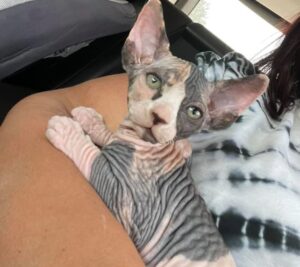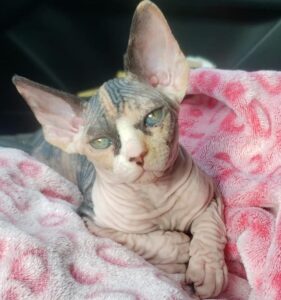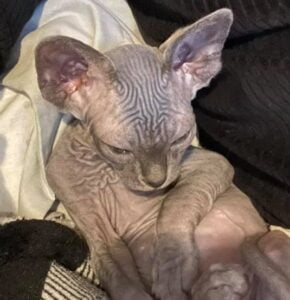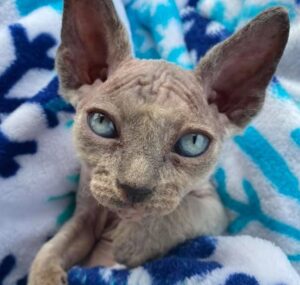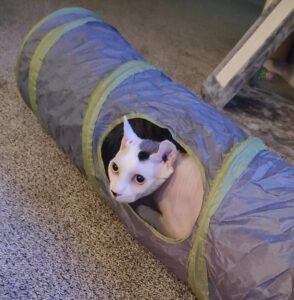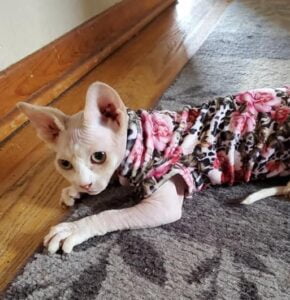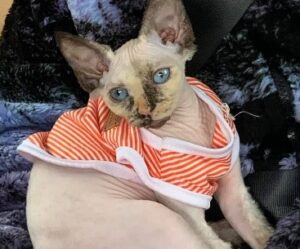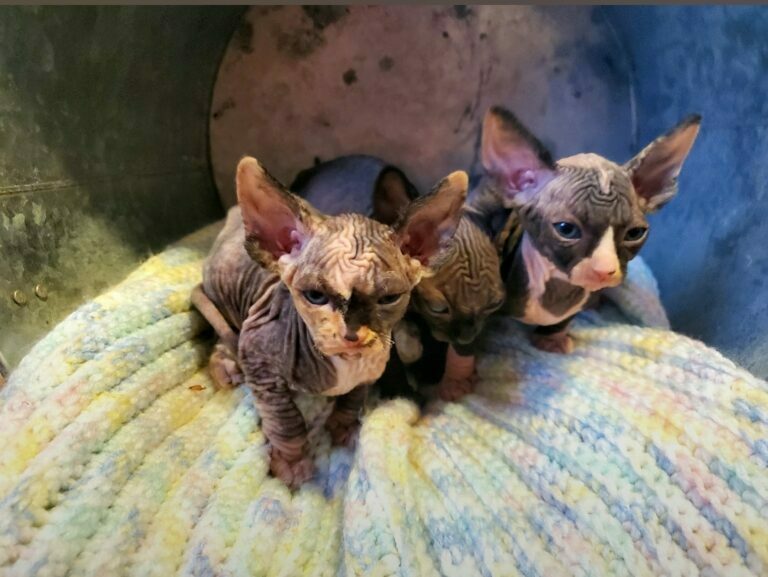Health
Cat Health
Your Cat's Health
You know your companion best so you’ll be the first to notice when something isn’t right. When your cat is sick, Dr. Google always gives you the worst case scenario. So here is our guild to some of the serious, but not common health conditions that potentially could affect your companion.
Note to readers: We are not veterinarians. Nor should this information be taken in lieu of veterinary advice. If you ever have a question about your companion’s health please consult your regular family veterinarian immediately.
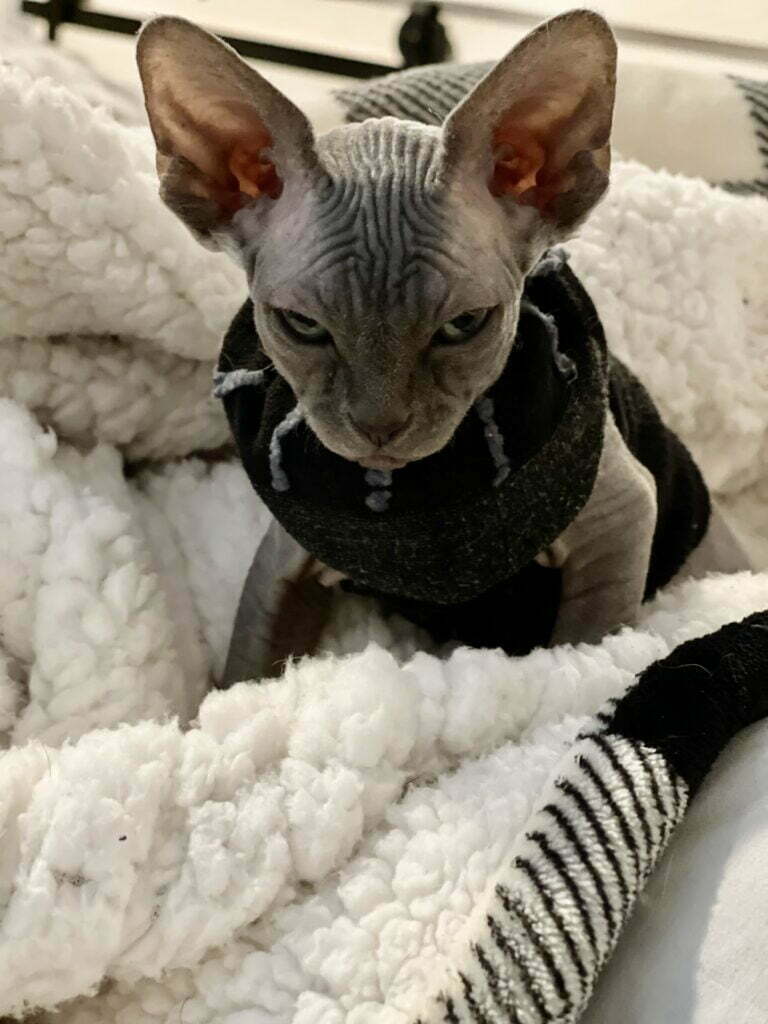
FIP
There is only one licensed FIP vaccine available, but this vaccine has questionable effectiveness in preventing FIP, and it is not routinely recommended by the American Association of Feline Practitioners Feline Vaccine Advisory Panel.
We have used an array of supplements over the years. We highly recommend Purina FortiFlora which is a powder digestive supplement for cats. Our cats love the taste, and it helps promote your companion’s digestive health as well as normalize intestinal microflora ( cats suffering from diarrhea). This product comes in individual packets and powder form to easily add a sprinkle on the top of any kind of food you use.
Another is pumpkin, yes pumpkin can provide an amazing source of fiber for your cats. We are now prepared with our homemade pumpkin cubes. When we open a can, we use silicone ice trays (mini) to make several pumpkin cubes and freeze to use as needed. We use Pumpkin when our cats have loose stools and / or diarrhea. You may find that it’s a love for them or you have to get clever and mix it in their regular cat food. Please be mindful of the canned pumpkin you are giving your cat as you should avoid canned pumpkin with added sugar or flavoring of any kind.
HCM
Feline Hypertrophic Cardiomyopathy (HCM) is a condition that causes the muscular walls of a cat’s heart to thicken, decreasing the heart’s efficiency and sometimes creating symptoms in other parts of the body. Although the cause of HCM has not been clearly identified, the fact that the condition is more prevalent in certain breeds (including Maine Coon, Ragdoll, British Shorthair, Sphynx, Chartreux and Persian cats) and that mutations of several cardiac (heart) genes have been identified in some cats with this disease suggests that genetics plays a role.
While the disease’s effects and prognosis (predicted outcome) may vary considerably, proper diagnosis and treatment can decrease the chance that a cat with HCM will experience certain symptoms and can improve his or her quality of life.
In a cat with HCM, the heart’s left ventricle (its primary “pump muscle”) is thickened, leading to a decrease in the volume of the heart chamber and to abnormal relaxation of the heart muscle. These changes can cause the heart to beat rapidly, resulting in increased oxygen usage and possibly to oxygen starvation of the heart muscle. This oxygen starvation may cause heart cells to die off, worsening heart function and leading to the development of arrhythmias (in which the heart beats too rapidly, too slowly, or with an irregular rhythm).
In addition to these difficulties, less efficient blood pumping may also lead to a backup of blood to the other chambers of the heart and to the lungs, which may contribute to the development of congestive heart failure or the formation of blood clots in the heart.
Vivamus integer non suscipit taciti mus etiam at primis tempor sagittis sit, euismod libero facilisi aptent elementum felis blandit cursus gravida sociis erat ante, eleifend lectus nullam dapibus netus feugiat curae curabitur est ad. Massa curae fringilla porttitor quam sollicitudin iaculis aptent leo ligula euismod dictumst, orci penatibus mauris eros etiam praesent erat volutpat posuere hac. Metus fringilla nec ullamcorper odio aliquam lacinia conubia mauris tempor, etiam ultricies proin quisque lectus sociis id tristique, integer phasellus taciti pretium adipiscing tortor sagittis ligula.

Clinical Signs
Many cats with HCM do not appear to be ill. Others may show signs of congestive heart failure, including labored or rapid breathing, open-mouthed breathing, and lethargy. These symptoms occur when fluid accumulates in or around the lungs.
A serious and potentially life-threatening consequence of HCM is the formation of blood clots in the heart. These clots may travel through the bloodstream to obstruct flow in other parts of the body (thromboembolism). The effect of the clot depends on its location, although in cats with HCM, clots most commonly result in blockage of blood flow to the hind limbs, causing acute hind limb pain or, in extreme cases, hind limb paralysis. Diagnosing HCM and treating the condition properly can help decrease the severity of clinical signs and may decrease the likelihood of thromboembolism.
Although relatively rare, cats with HCM are at risk for sudden death.
Diagnosis
HCM is diagnosed by echocardiography, a technology that uses sound waves to create an image of the heart. In cats with HCM, these images reveal the thickened walls and constricted volume of the left ventricle of the heart. However, similar heart thickening is also caused by other common conditions, including high blood pressure and hyperthyroidism. These diseases must be ruled out prior to diagnosing HCM. Your veterinarian may also recommend other tests, including chest radiographs and electrocardiography, depending on the results of a physical examination and/or echocardiographic findings.
New genetic tests may also help identify whether your cat has an increased risk of HCM, but the results of these screening tests should be interpreted carefully with the guidance of a veterinary professional, since not all cats that have these mutations will develop the condition.
Treatment
Although HCM has no known cure, a specialized care plan can help manage clinical signs of the condition in your cat. Treatment goals include controlling the heart rate, alleviating lung congestion (congestive heart failure), and preventing the formation of blood clots that can lead to thromboembolism.
Medication can help manage HCM, and can be administered orally to stable patients or by injection in more serious situations. Other drugs, such as nitroglycerine, may be applied to the cat’s skin for absorption.
Unfortunately, no therapy has been shown to prevent the progression of HCM when started before clinical signs are observed.
Prognosis
The prognosis (predicted outcome) for cats with HCM is variable. Cats that do not display any clinical signs are often able to survive for years with only mildly compromised heart function.
HCM is most commonly a progressive disease, and findings that suggest a worse prognosis include congestive heart failure, thromboembolism, and hypothermia (low body temperature). However, in many cases, medical therapy can significantly improve your cat’s quality of life.
Our Role
Here at Pantheon Sphynx, we take measures to decrease the spread of HCM. Our cats are scanned yearly at Oakwood Veterinary Hospital in Bloomfield, MI. Our kittens get HCM DNA tested prior to leaving our home.
Parasites
What You Need To Know About Parasites In Cats
Here is a go-to guide for parasites in cats.
Types of Parasites in Cats
- Heartworms
- Intestinal parasites
- External parasites
Heartworm in cats
These worms live in your cat’s pulmonary artery and can potentially be fatal, since the parasites can end up blocking vessels that bring blood to his lungs.
Intestinal parasites in cats
- Tapeworms
- Hookworms
- Roundworms
- Whipworms
- Giardia
External parasites in cats
- Fleas
- Ticks
- Mites
- Toxoplasmosis
Mites include things like:
- Demodex (lives in your cat's hair follicles)
- Scabies (lives on his skin)
- Cheyletiellosis (aka walking dandruff, lives on his skin)
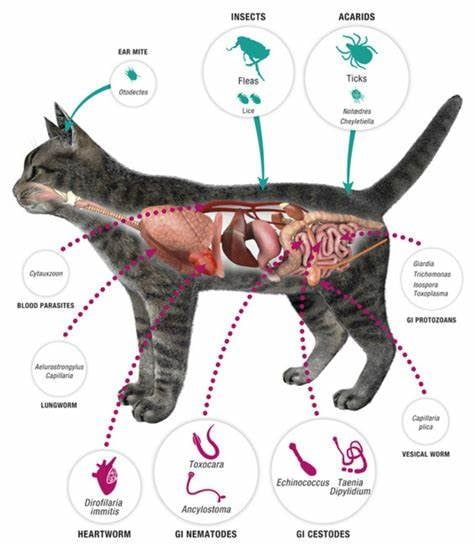
Cat Parasite Symptoms
Symptoms of intestinal parasites in cats might include things like:
- Diarrhea
- Weight loss
- Coughing
- Vomiting
- Itching
- Hair loss
- Skin irritation
How to tell if your cat has fleas or ticks
Signs your cat might have fleas include:
- Scratching
- Thinning hair
- Excessive grooming
- Small bumps
- Bugs on his skin or in his fur
When it comes to intestinal parasites in cats, the following treatments could clear up his infection:
- Praziquantel: for tapeworms
- Emodepside: for hookworms and roundworms
- Pyrantel: for hookworms and roundworms
- Fenbendazole: for whipworms and giardia
For external parasites, there are lots of great products on the market to fight fleas, ticks and mites. And toxoplasmosis can be cleared up using antibiotics and steroids.
Viruses
Biologists sometimes describe them as “organisms at the edge of life”, as they closely resemble living organisms but they don’t have a cellular structure nor their own metabolism and they do not grow through cell division. They infect a host cell, integrate themselves in the cell and redirect the cell to produce their products and multiple copies of themselves.
• Core: all cats should receive the vaccine regardless of circumstances,
• Non-core: recommendation based on risk for exposure to disease (i.e. location and lifestyle),
• Not generally recommended: not recommended due either lack of evidence of effectiveness or a high chance for adverse;
Most common viruses in cats
1. Feline Immunodeficiency Virus (FIV)
Feline Immunodeficiency Virus (FIV) is a lentivirus affecting from 2.5% to 4.4% cats worldwide. FIV is taxonomically different from the other two feline retroviruses, feline leukemia virus (FeLV) and feline foamy virus (FFV) and is more closely related to human immunodeficiency virus (HIV).
FIV is the only lentivirus causing a disease similar to AIDS in non-primates. FIV is not lethal for cats, and they can live relatively healthy as FIV carriers. Vaccines for this virus have been designed, but the vaccination against FIV is classified as “non-core”.
FIV is one of the most common viruses in cats, but the vaccination is classified as “non-core”
FIV can compromise the cat’s immune system and it infects many cells including T lymphocytes (specifically CD4+ and CD8+), B lymphocytes and macrophages. Cats can usually handle the disease caused by FIV quite well, and only in 5% of the cases their immune system debilitates and leads to the exhaustion of T-helper cells. In humans, this percentage is much higher and is estimated to be around 50%.
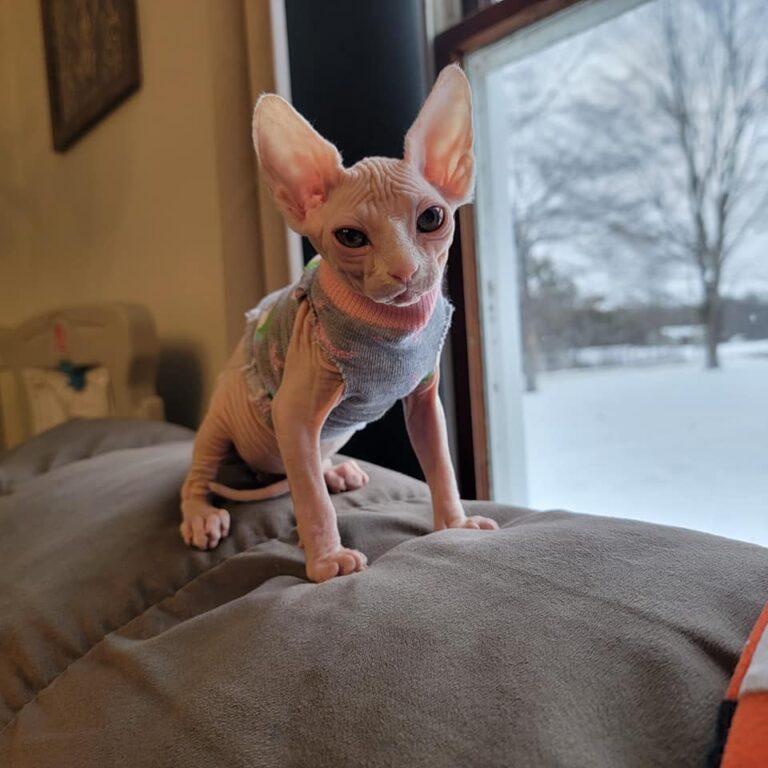
2. Feline Coronavirus (FCoV)
Feline Coronavirus (FCoV) is a positive-stranded RNA virus that causes a fatal, aberrant immune response called Feline infectious peritonitis (FIP) in cats. FCoV is a gastrointestinal virus and the infections are usually asymptomatic or coupled with diarrhea. There are two main forms of FIP: effusive (wet) and non-effusive (dry). While both types are fatal, the effusive form is more common (60–70% of all FIP cases) and progresses more rapidly than the non-effusive form.
The effusive FIP is characterized by the accumulation of fluid in the cat’s abdomen or chest. This leads to breathing difficulties, lack of appetite, fever, diarrhea and weight loss. In non-effusive FIP, the cats show similar symptoms of infection but there are no fluid accumulations. Cats suffering from this type of FIP will often show ocular or neurological signs too. The vaccination against FIP does exist, but it is classified as “not generally recommended”.
FCOV is also one of the most common viruses in cats, but the vaccination is classified as “not generally recommended”
3. Feline Leukemia Virus (FeLV)
Feline leukemia virus (FeLV) affects only cats. It is transmitted via saliva or nasal secretion. If not defeated, it can cause a disease that can be lethal. It is categorized into four subgroups: A, B, C and T. Symptoms, prognosis and treatment depend on the subgroups.
The effects of the disease caused by this virus are diverse. The cat can either fight off the infection completely and become immune, it can also be a healthy, unaffected carrier or it can have a compromised immune system. The final stage of the disease is the development of lymphomas. The vaccination is possible and classified as “non-core”.
4. Feline Panleukopenia Virus (FPV)
Feline panleukopenia virus (FPV), also referred to as feline distemper, feline ataxia or cat plague is a viral infection caused by feline parvovirus. It affects both domestic and wild cats. Once contracted, it is highly contagious and can be fatal to the affected cats. The name panleukopenia comes from the low white blood cell count (leucocytes) exhibited by affected animals.
Panleukopenia can be spread via bodily fluids, feces or fleas. It primarily attacks the cells of the gastrointestinal tract lining which can further cause sloughing of the intestinal epithelium. This can further lead to diarrhea, dehydration, malnutrition, anemia and even death. The vaccination is classified as “core“ and is highly recommended for all cats.
FPV is one of the most common viruses in cats and the vaccinations are “core” and recommended to ALL cats
5. Feline Calicivirus (FCV)
The symptoms can occur chronically, acutely or not at all. Acute signs include fever, nasal discharge, sneezing, stomatitis and conjunctivitis. When coupled with bacterial infections, pneumonia can develop too. The FCV can’t be specifically treated, but antibiotics are often used to treat secondary bacterial infections and immune modulators that can sometimes couple the viral infection. The vaccination is classified as “core”.
6. Feline Herpesvirus
Feline herpesvirus is transmitted directly and it replicates in the tonsils and nasal and nasopharyngeal tissues. The signs of the infections include coughing, sneezing, nasal discharge, conjunctivitis, lack of appetite and fever. The vaccination against the feline herpesvirus is also classified as “core”.
7. Rabies
Rabies is one of the most common viruses in cats and it causes devastating and lethal disease. Pet vaccinations against it are legally obligate in some parts of the world, but not everywhere.
Most commonly, rabies is transmitted through a bite from an infected animal. It can also be transmitted if saliva of an infected animal comes in contact with an open wound or mucous membranes of another animal. Unvaccinated cats allowed to go outdoors are at the highest risk for rabies.
“Outdoor cats may, in the course of daily life, get into a fight with an infected wild animal or an infected stray dog or cat. And although widespread vaccination programs have helped to control rabies in dogs, feral cat populations remain a reservoir host for the rabies virus.” – explained WebMD.
The most accurate diagnostic test for rabies is the direct fluorescent antibody test. However, this can only be performed when the animal has already deceased. The accurate diagnosis in living animals is a lot more difficult. After incubation, the virus can remain in the cat’s body anywhere from one week to more than a year before it activates itself. Once activated, the signs occur very quickly.
The vaccination against rabies is somewhere classified as “core”, somewhere as “non-core”, but in some countries it is obligatory.
These were just 7 of the most common viruses diagnosed in cats, among many more that can afflict our pets. Viruses can be very dangerous and it is therefore highly important to regularly vaccinate our cats and protect them from viral infections.
Consult with a veterinarian professional about the vaccination program for your cat. They will advise the recommended vaccines according to your location and your cat’s lifestyle.
What Our Families Have To Say
